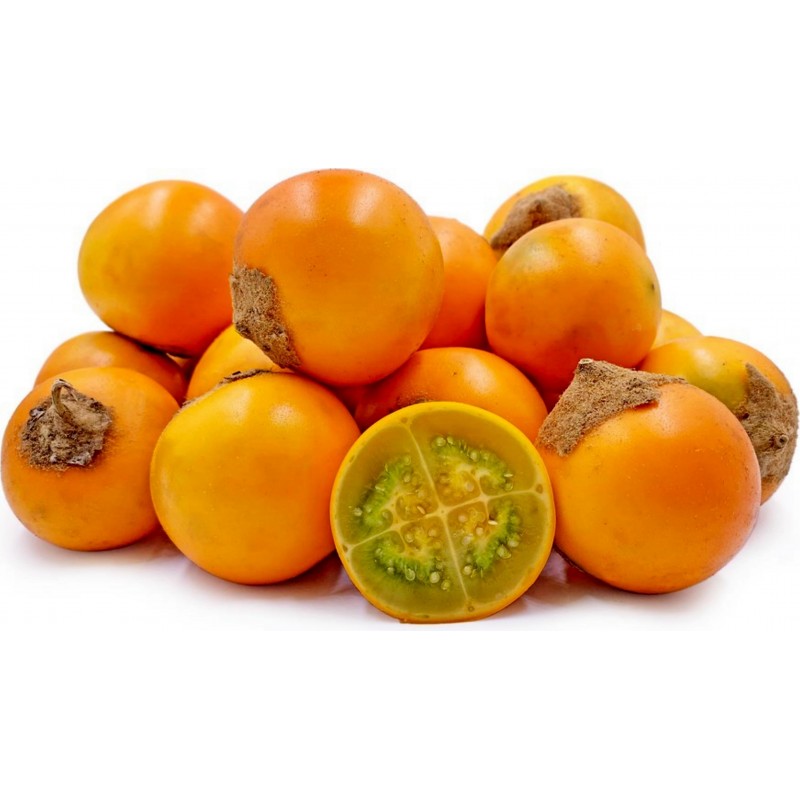







Naranjilla (Solanum quitoense). Large subtropical plant from the andean plateau where it is grown for its delicious orange fruits. National fruit of Ecuador. Small, 3 to 5 cm orange fruits
Solanum quitoense, known as naranjilla (Spanish pronunciation: [naɾaŋˈxiʎa], "little orange") in Ecuador and Panama and as lulo ([ˈlulo], from Quechua) in Colombia, is a subtropical perennial plant from northwestern South America. The specific name for this species of nightshade means "from Quito."
The naranjilla plant is attractive, with large elongated heart- or oval-shaped leaves up to 45 cm in length. The leaves and stems of the plant are covered in short purple hairs. Naranjilla is a delicate plant and must be protected from strong winds and direct sunlight. They grow best in partial shade.
The fruit has a citrus flavor, sometimes described as a combination of rhubarb and lime. The juice of the naranjilla is green and is often used as a juice or for a fermented drink called lulada.
Within the genus Solanum, S. quitoense is a part of the subgenus Leptostemonum. Within this clade, S. quitoense belongs to the section Lasiocarpa. Other species within Lasiocarpa include: S. candidum, S. hyporhodium, S. lasiocarpum, S. felinum, S. psudolulo, S. repandum and S. vestissimum.

Other plants bear morphological similarity to S. quitoense, but they may or may not be closely related. Some of these plants are: S. hirtum, S. myiacanthum, S. pectinatum, S. sessiliflorum and, S. verrogeneum. Many of these plants, related or not, can be confused with S. quitoense. Furthermore, Solanum quitoense's physical traits vary from plant to plant, making identification challenging: at least three varietals (with spines, without spines, or a third variety known as baquicha, which features red-ripening fruits and smooth leaves) are known to occur. One characteristic that is unique to S. quitoense is the ring of green flesh within the ripe fruit.[1] The only related fruit to have green flesh is a cultivated variant of S. lasiocarpum.
The new growth of this plant is densely covered in protective trichomes. Coloration in the plant's trichomes around the new growth and flowers varies from purple to white. Identification can be difficult for this reason.
The naranjilla has been proposed as a new flavoring for the global food industry, but it fares poorly in large-scale cultivation, presenting an obstacle to its wider use. Its fruit, like tomatoes, is easily damaged when ripe, so it is usually harvested unripe. The fruits are found in markets. It is common for locals to make beverages by adding sugar and water to the freshly squeezed fruits.

Solanum quitoense has limited potential in agriculture due to the plant's extreme vulnerability to pests and diseases when grown as a crop. One common type of infection is caused by the root-knot nematode. The ripe fruit is very delicate and is frequently attacked by fungus, especially when mechanically damaged, so it is often picked unripe to avoid rotting.
Hybrids are an increasingly popular solution to the nematode pest problem. S. quitoense has been hybridized with other plants, most commonly with S. sessiliflorum, a plant with similar phenotypic traits. The leaves, flowers and fruits of S. sessiliflorum are similar in form to S. quitoense, but has much larger fruits that are yellow; the resulting hybrids have fruits with yellowish fruit pulp.


Contents of the fruit varies from region to region. These statistics are based on Costa Rican fruit:
| fruit nutrients | percent contained in fruit |
|---|---|
| Water | 90% |
| Protein | 1% |
| Fat | less than .0001% |
| Carbohydrates | 3.8% |
| Fiber | 1.4% |
| Sugar | 3% |
| Calories | (kcal/100g) 18 |
| Vitamin C | 2.6% |
These statistics are based on fruits found in Colombia and Ecuador:
| Fruit nutrients | mg per 100g of nutrients. |
|---|---|
| Calcium | 5.9–12.4 mg |
| Phosphorus | 12.0–43.7 mg |
| Iron | 0.34–0.64 mg |
| Carotene | 0.071–0.0232 mg |
| Thiamine | 0.04–0.094 mg |
| Riboflavin | 0.03–0.047 mg |
| Niacin | 1.19–1.76 mg |
|
Sowing Instructions |
|
|
Propagation: |
Seeds |
|
Pretreat: |
soak in warm water for 2-4 hours |
|
Stratification: |
0 |
|
Sowing Time: |
all year round |
|
Sowing Depth: |
Seeds only slightly cover with the substrate |
|
Sowing Mix: |
Coir or sowing mix + sand or perlite |
|
Germination temperature: |
23-25 ° C |
|
Location: |
bright + keep constantly moist not wet |
|
Germination Time: |
usually between 2 to 4 weeks, or longer. |
|
Watering: |
watering during the growing season plentiful |
|
|
|
Adatlap
 Reviews (0)
Reviews (0)